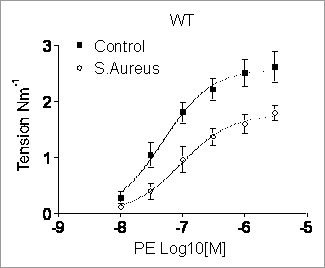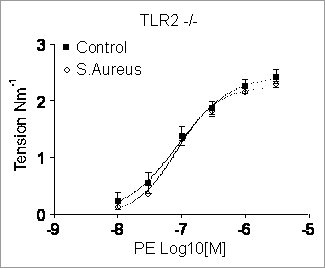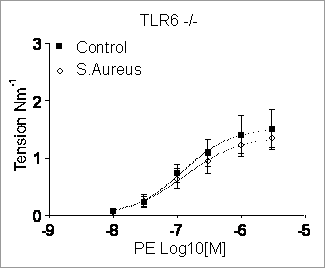Print version
Search Pub Med
Role of TLR2 and TLR6 in vascular dysfunction induced by Gram positive bacteria Septic shock is the leading cause of death in adult intensive care units in the UK: The causative pathogen in over 60% of cases is Gram positive bacteria. The vascular dysfunction seen in sepsis is characterised by hyporesponsivess to vasoconstrictor agents, which in rodents is mediated by the induction of NOSII. This leads to a fall in systemic vascular resistance and is pivotal to the ensuing shock, multi organ dysfunction and frequent outcome of death. In macrophages Gram positive bacteria are sensed by Toll like receptor (TLR)-2, which can heterodimerise with either TLR1 or TLR6. The precise role of TLRs in bacteria activation of blood vessels in not known. Our aim was therefore to determine the role of TLR2, TLR1 and TLR6 in vascular dysfunction induced by Gram positive pathogens. Wild type C57Bl/6 mice or gene knockouts, TLR1-/-, TLR2-/-, TLR4-/- or TLR6-/- (males of weight 25-34g) were killed, aortae removed and cut into rings. These aortic rings were cultured in DMEM alone (controls) or containing heat killed S.Aureus (108 CFU/ml), the TLR2-6 ligand MALP-2 (1µg/ml) or the TLR1-2 ligand Pam3CSK4 (5µg/ml). After 24h culture the aortic rings were mounted on a DMT wire myograph in physiological saline solution containing 10-4M L-Arginine at 37°C bubbled with 5%CO2, 95%O2 (PSS). Vessels were normalised in the way as previously described phenylephrine (PE) was then added (10-8 – 3x10-6 M) and isometric force was measured and tension calculated from vessel length. The vessels were then washed with PSS and incubated with the NOSII inhibitor 1400W (10-5M) for 30 minutes before PE induced responses were repeated. All results were analysed using a two-way ANOVA. Vessels from wild-type mice or from TLR1-/- or TLR4-/- mice were hyporesponsive to PE after culture with S.Aureus or MALP-2 (n=6; p<0.05) when compared to vessels cultured with medium alone. Vessels from TLR2-/- or TLR6-/- mice were resistant to the effects of either S.Aureus or MALP-2 (n=6; p>0.05 compared to control; Figure 1). Pam3CSK4 had no effect on vessel contractility in wild-type mice (n=6, P>0.05). The hyporesponsiveness to PE induced by either S.Aureus or MALP-2 was significantly reduced by 1400W in all cases (n=6; p<0.05). Thus, the ability of Gram positive bacteria to induce vascular hyporesponsiveness is mediated exclusively via TLR2 and TLR6 and not TLR4 or TLR1, most probably through a TLR2-6 heterodimer. These observations illustrate the potential of TLR6 as a therapeutic target for the treatment of Gram positive sepsis.
Figure 1 TLR2 and 6 are essential in the response to gram positive S.Aureus. |




